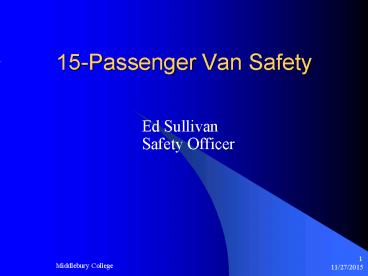15-Passenger Van Safety - PowerPoint PPT Presentation
1 / 23
Title: 15-Passenger Van Safety
1
15-Passenger Van Safety
- Ed Sullivan
- Safety Officer
2
Introduction
- 15-Passenger Vans Safety Concerns
- Previous College Policy
- Response to NHTSA Report
- Classroom Training
- Practical Hands On Training
3
Agenda
- NHTSA Report
- Accident Facts
- 15-Passenger Van Facts
- Driving Tips
- Check-Out Procedures
- Break
- NSC Van Safety Program
4
Vocabulary
- NHTSA National Highway Transportation Safety
Administration. - NSC National Safety Council
- CDL Commercial Drivers License
5
NHTSA Report
- 15-passenger vans have a increased rollover risk
under certain conditions - The risk of rollover increases dramatically as
the number of occupants increases from fewer than
five occupants to over ten passengers. - 15-passenger vans (with 10 or more occupants) had
a rollover rate in single vehicle crashes that is
nearly 3 x the rate of those that were lightly
loaded.
6
NHTSA Report (continued)
- Loading 15-passenger vans causes the center of
gravity to shift rearward and upward increasing
the likelihood of rollover. Shift in the center
of gravity will also increase the potential for
loss of control in panic maneuvers. - It is important that the van be operated by
experienced drivers, they should understand and
be familiar with the handling characteristics of
their vans, especially when fully loaded.
7
NHTSA Reports (continued)
- Institutions using 15-passenger vans should
require seat belt use at all times. - Any load placed on the roof will be above the
center of gravity of the vehicle and will
increase the likelihood of rolling over.
8
NHTSA OVERHEADS
- Figure 1, Light Vehicle Crashes
- Figure 2, Fatal Crashes
- Figure 3, Single Vehicle Rollovers
- Figure 4, Rollover Rate by Vehicle Type
- Figure 5, Rollover by Vehicle Type
- Figure 6, Rural Road Rollover
- Figure 7, Freeway Rollover
- Figure 8, Out of Control Vehicle
- Figure 9, Vehicle Under Control
- http//www.nhtsa.dot.gov/hot/rollover/figures.html
9
Overview
- 15-passenger Vans should be operated by
experienced drivers. - In order to insure we have the most qualified
drivers we now require - 3 years of driving experience
- Successfully complete classroom program
- Successfully complete a road test
10
Accident Facts
- 25 of all driving accidents are the result of
excessive speed. - 70 of driving accidents occur within 25 miles
from home. - 1 out of 4 employees who drive experience an
accident while at work. - Most people know someone who has died in a car
accident.
11
15-Passenger Van Facts
- A speed that may be acceptable in a passenger car
could be dangerous in a van. - A 16 passenger vehicle requires a CDL
- You should fill the front seats first. The
center of gravity shifts to the rear and upward
increasing the likelihood of rollover as capacity
increases. - Soft shoulders and culverts pose a hazard in
rural areas. - The shift in the center of gravity will also
increase the potential for loss of control in
panic maneuvers.
12
Driving Tips
- For all kinds of vehicles.
- Defensive Driving Theories
- Dealing with aggressive drivers
- Backing the vehicle
- Highway driving
- City Driving
- Rural Driving
- Emergency situations
- Vehicle accidents
13
Driving Tips for all vehicles
- Avoid sharp turns.
- Avoid excessive speed and abrupt maneuvers.
- Dont drive tired.
- Dont drive in bad weather
- Drive conservatively
- Rest stops often (every 2 hrs. recommended)
- Wear seat belts
- Drive during the day, if possible.
- Require someone to be awake in the front seat
with the driver on long trips
14
For all vehicles (continued)
- 2-way radio for all vehicles and cellular phone
for leader on multi-vehicle trips. - Trip leader to drive lead vehicle and set pace. .
.no other vehicle shall pass. - Obey all laws, signs and speed limits.
15
Defensive Driving Theories
- Drive with courtesy
- Be calm when driving
- Concentrate when driving
- Drive cautiously
16
Dealing With Aggressive Drivers
- Avoid eye contact.
- Dont cut in front of other drivers.
- Allow fellow drivers to merge
- Dont aggravate fellow drivers with hand
gestures. - Dont tailgate.
- Use your horn sparingly.
17
Backing The Vehicle
- Use a spotter
- Back to the left (drivers side)
- Avoid backing up if you miss a ramp/exit.
- Use outside mirrors.
18
Highway Driving
- Lane changes and signals.
- Merges
- Blind Spots
- Slow moving vehicles
19
City Driving
- Stop signs
- Stop lights
- Yield Signs
- Signals
- Blind spots
- Pedestrians
- Bicyclist
20
Rural Driving
- Bicyclist
- Walkers
- Deer/Moose
- Soft shoulders
- Culverts
- Curves, hills and narrow roads
21
Emergency Situations
- Encountering emergency vehicles
- Headlights go out
- Tire blow out
- Engine failure
- Break Failure
22
Check-Out Procedures
- Vehicle usage must be pre-approved by the budget
administrator for your department or
organization. - Arrangements are made through the Purchasing
Department. - Drivers must have a valid state drivers license
and MC drivers license. - Keys must be picked up by the driver.
- Inspect the vehicle and report any problems.
23
Vehicle Accident
- Relax
- Never leave the scene of an accident.
- Report the accident to the police.
- Never admit fault.
- Gather all the facts (date, time, witnesses,
phone numbers, etc.) - Immediately report all accidents to Security,
Supervisor or Commons Dean/Student Activities.































